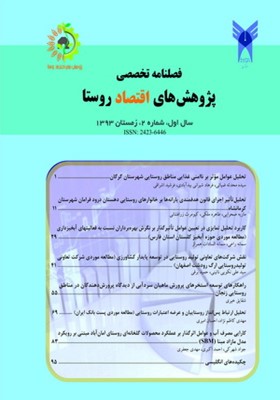تحلیل اقتصادی رابطه بین اعتبارات کشاورزی و فقر روستایی در ایران: رهیافت بیزی
محورهای موضوعی : پژوهشهای اقتصاد روستاطاهره آهنی 1 , احمد علی رضایی 2 , محمد بخشوده 3
1 - کارشناس ارشد مهندسی اقتصاد کشاورزی، دانشگاه شیراز
2 - کارشناس ارشد علوم اقتصادی، دانشگاه اصفهان
3 - استاد بخش اقتصاد کشاورزی، دانشگاه شیراز
کلید واژه: رشد بخش کشاورزی, اعتبارات مالی, رهیافت خود رگرسیون برداری بیزی,
چکیده مقاله :
اعتبارات مالی بهعنوان یکی از راههای انباشت سرمایه و درنتیجه کاهش فقر روستایی حائز اهمیت میباشد. لذا در این مطالعه ابتدا رابطه بین اعتبارات مالی تخصیص دادهشده به بخش کشاورزی و فقر روستایی بررسی میشود. سپس از طریق تعریف سناریوهای مختلف، آزمون میشود که تغییر در حجم اعتبارات مالی تخصیصی به بخش کشاورزی چه اثری بر فقر روستایی خواهد داشت. بهمنظور بررسی اهداف فوق، از برآورد الگوی اقتصادسنجی خود رگرسیون برداری بیزی (BVAR) و همچنین شبیهسازی سناریوهای تعریفشده در مدل بیزین بهرهگیری شده است. بدین منظور کلیه محاسبات و عملیات ریاضی این پژوهش با استفاده از نرمافزارهای Eviews7و Matlab6و دادههای سری زمانی 1391-1361 برای کشور ایران انجامشده است. یافتههای این مطالعه نشان میدهد که اعتبارات اعطایی به بخش کشاورزی دارای اثر مثبت بر رشد درآمد و کاهش فقر در این بخش بوده است که این اثر مثبت با افزایش حجم اعتبارات حداقل تا دو برابر مقدار فعلی، روند افزایشی چشمگیری خواهد داشت. همچنین یافتهها نشان میدهد که رشد درآمد در بخش کشاورزی نیز اثرگذاری مثبتی بر حجم اعتبارات اعطایی به این بخش دارد.
Quantity and quality of resources allocated to the agricultural sector, the amount of employed capital and the level of knowledge and technical equipment of producers are factors affecting on growth of this sector and reduction rural poverty. One of the main problems in agriculture is lack of capital so funding can be considered as a way of capital accumulation and thus reduces rural poverty. Therefore, in this study we examined the relationship between allocated funding to agriculture and rural poverty. Then, by definition of scenarios, we test whether the change in the volume of allocated credit to agricultural sector will have impact on rural poverty? To verify the above objectives, we used econometric model Bayesian Vector Autoregressive and also Simulation of defined scenarios, reducing allocation funding to zero, getting funding in the actual amount and increase of allocated funding to twice of initial value in Bayesian model. Therefore, all calculations and mathematical operations in this research performed by Eviews7 and Matlab6 and using time series data from for 1980 to 2012, Iran. The main findings of this study show that allocated funding to agricultural sector has a positive effect on income growth and poverty reduction in this sector. The positive effect will have increasing trend with increasing of at least credit amount to double of current amount. Also results show that income growth in the agricultural sector has positive effects on volume of credit granted to this sector.


